Study on Soil Moisture Status of Soybean and Corn across the Whole Growth Period Based on UAV Multimodal Remote Sensing
Abstract
:1. Introduction
2. Materials and Methods
2.1. Experimental Site and Setup
2.2. Data Acquisition
2.2.1. UAV Data
2.2.2. In Situ Soil Moisture
2.3. Methods
2.3.1. Regression Model Building
2.3.2. Validation
3. Results
3.1. Modeling and Validation of Soil Moisture Content
3.1.1. The Relationship between Vegetation Indices and Soil Moisture
3.1.2. Model Performance
3.2. Contributions of Different Sensor Data
3.3. Comparison of Estimation Accuracy at Different Soil Depths
3.4. Accuracy Comparison and Optimal Estimation Depths for Different Growth Stages
3.5. Spatial Distribution of Soil Moisture in the Field
4. Discussion
5. Conclusions
- (1)
- For different crop growth stages and soil depths, multispectral remote sensing data outperformed thermal infrared remote sensing in terms of SMC estimation accuracy. Moreover, combining thermal infrared remote sensing data with multispectral data improved the accuracy of SMC estimation. The combined approach achieved a 14% increase in R2 compared to using multispectral data alone and a 39% increase compared to using thermal infrared data alone.
- (2)
- Across the entire growth period, the optimal SMC estimation depths for soybean were found to be 10 cm and 20 cm, with a significant correlation between them. The average R2 for these depths were 0.81 and 0.82, respectively. In contrast, the accuracy decreased for depths between 40 cm and 80 cm, with all R2 below 0.4. For corn, the optimal SMC estimation depths were 10 cm, 20 cm, and 40 cm, with average R2 of 0.59, 0.60, and 0.55, respectively. The performances at depths of 60 cm and 80 cm were poorer, with all R2 below 0.3.
- (3)
- From the perspective of different growth stages, the SMC estimation model performed well for both crops during the first three growth stages and decreased in accuracy during the maturity stage. On average, corn showed a decrease of 0.35 in R2, while soybean showed a decrease of 0.26. In terms of the optimal estimation depth across the first three growth stages, the optimal estimation depths for both soybean and corn are relatively stable, with soybean at 10 cm and 20 cm, and corn at 10 cm, 20 cm, and 40 cm.
Supplementary Materials
Author Contributions
Funding
Data Availability Statement
Conflicts of Interest
References
- Zhang, L.; Xia, J.; Hu, Z. Situation and problem analysis of water resource security in China. Resour. Environ. Yangtze Basin 2009, 18, 116–120. [Google Scholar]
- Kang, S.; Su, X.; Tong, L.; Shi, P.; Yang, X.; Abe, Y.; Du, T.; Shen, Q.; Zhang, J. The impacts of human activities on the water–land environment of the Shiyang River basin, an arid region in northwest China. Hydrol. Sci. J. 2004, 49, 413–427. [Google Scholar] [CrossRef]
- Kang, S.; Hao, X.; Du, T.; Tong, L.; Su, X.; Lu, H.; Li, X.; Huo, Z.; Li, S.; Ding, R. Improving agricultural water productivity to ensure food security in China under changing environment: From research to practice. Agric. Water Manag. 2017, 179, 5–17. [Google Scholar] [CrossRef]
- Wang, Q.; Mei, X. Strategies for Sustainable Use of Agricultural Water Resources in China. J. Agric. 2017, 7, 80–83. [Google Scholar]
- Seneviratne, S.I.; Corti, T.; Davin, E.L.; Hirschi, M.; Jaeger, E.B.; Lehner, I.; Orlowsky, B.; Teuling, A.J. Investigating soil moisture–climate interactions in a changing climate: A review. Earth-Sci. Rev. 2010, 99, 125–161. [Google Scholar]
- Luo, W.; Xu, X.; Liu, W.; Liu, M.; Li, Z.; Peng, T.; Xu, C.; Zhang, Y.; Zhang, R. UAV based soil moisture remote sensing in a karst mountainous catchment. Catena 2019, 174, 478–489. [Google Scholar]
- McColl, K.A.; Alemohammad, S.H.; Akbar, R.; Konings, A.G.; Yueh, S.; Entekhabi, D. The global distribution and dynamics of surface soil moisture. Nat. Geosci. 2017, 10, 100–104. [Google Scholar] [CrossRef]
- Lei, Z.; Hu, H.; Yang, S. A Review of Soil Water Research. Adv. Water Sci. 1999, 10, 311–318. [Google Scholar]
- Gago, J.; Douthe, C.; Coopman, R.E.; Gallego, P.P.; Ribas-Carbo, M.; Flexas, J.; Escalona, J.; Medrano, H. UAVs challenge to assess water stress for sustainable agriculture. Agric. Water Manag. 2015, 153, 9–19. [Google Scholar]
- Guo, X.; Cheng, G. Advances in the application of remote sensing to evapotranspiration research. Adv. Earth Sci. 2004, 19, 107–114. [Google Scholar]
- Cheng, M.; Jiao, X.; Liu, Y.; Shao, M.; Yu, X.; Bai, Y.; Wang, Z.; Wang, S.; Tuohuti, N.; Liu, S.; et al. Estimation of soil moisture content under high maize canopy coverage from UAV multimodal data and machine learning. Agric. Water Manag. 2022, 264, 107530. [Google Scholar] [CrossRef]
- Zhang, Z.; Wang, H.; Han, W.; Bian, J.; Chen, S.; Cui, T. Inversion of Soil Moisture Content Based on Multispectral Remote Sensing of UAVs. Trans. Chin. Soc. Agric. Mach. 2018, 49, 173–181. [Google Scholar]
- Guo, H.; Bu, X.; Huang, K.; Liu, Y. Inversion of soil moisture in corn field based on thermal infrared remote sensing image. J. Chin. Agric. Mech. 2020, 41, 203–210. [Google Scholar]
- Qiu, J.; Crow, W.T.; Wang, S.; Dong, J.; Li, Y.; Garcia, M.; Shangguan, W. Microwave-based soil moisture improves estimates of vegetation response to drought in China. Sci. Total Environ. 2022, 849, 157535. [Google Scholar] [CrossRef]
- Pan, N.; Wang, S.; Liu, Y.; Zhao, W.; Fu, B. Advances in soil moisture retrieval from remote sensing. Acta Ecol. Sin. 2019, 39, 4615–4626. [Google Scholar]
- Liu, W.; Baret, F.; Gu, X.; Tong, Q.; Zheng, L.; Zhang, B. Relating soil surface moisture to reflectance. Remote Sens. Environ. 2002, 81, 238–246. [Google Scholar]
- Yu, T.; Tian, G. The Application of Thermal Inertia Method the Monitoring of Soil Moisture of North China Plain Based on NOAA-AVHRR Data. J. Remote Sens. 1997, 1, 24–31. [Google Scholar]
- Yang, Y.; Qiu, J.; Su, H.; Tian, J.; Zhang, R. Estimation of surface soil moisture based on thermal remote sensing: Intercomparison of four methods. J. Infrared Millim. Waves 2018, 37, 459–467, 476. [Google Scholar]
- Wang, H.; Zhang, Z.; Fu, Q.; Chen, S.; Bian, J.; Cui, T. Inversion of Soil Moisture Content Based on Multispectral Remote Sensing Data of Low Altitude UAV. Water Sav. Irrig. 2018, 102, 90–94. [Google Scholar]
- Sedaghat, A.; Shahrestani, M.S.; Noroozi, A.A.; Fallah Nosratabad, A.; Bayat, H. Developing pedotransfer functions using Sentinel-2 satellite spectral indices and Machine learning for estimating the surface soil moisture. J. Hydrol. 2022, 606, 127423. [Google Scholar] [CrossRef]
- Zhou, Y.; Lao, C.; Yang, Y.; Zhang, Z.; Chen, H.; Chen, Y.; Chen, J.; Ning, J.; Yang, N. Diagnosis of winter-wheat water stress based on UAV-borne multispectral image texture and vegetation indices. Agric. Water Manag. 2021, 256, 107076. [Google Scholar] [CrossRef]
- Ren, S.; Guo, B.; Wang, Z.; Wang, J.; Fang, Q.; Wang, J. Optimized spectral index models for accurately retrieving soil moisture (SM) of winter wheat under water stress. Agric. Water Manag. 2022, 261, 107333. [Google Scholar] [CrossRef]
- Li, Z.; Leng, P.; Zhou, C.; Chen, K.; Zhou, F.; Shang, G. Soil moisture retrieval from remote sensing measurements: Current knowledge and directions for the future. Earth-Sci. Rev. 2021, 218, 103673. [Google Scholar] [CrossRef]
- Yang, S.; Chen, J.; Zhou, Y.; Cui, W.; Yang, N. A Study on the Method of UAV Thermal Infrared Remote Sensing to Retrieve Soil Moisture Content in Corn Root Zone. Water Sav. Irrig. 2021, 12–18. [Google Scholar]
- Zhang, Z.; Xu, C.; Tan, C.; Bian, J.; Han, W. Influence of Coverage on Soil Moisture Content of Field Corn Inversed from Thermal Infrared Remote Sensing of UAV. Trans. Chin. Soc. Agric. Mach. 2019, 50, 213–225. [Google Scholar]
- Zhao, Z.; Wang, H.; Qin, D.; Wang, C. Large-scale monitoring of soil moisture using Temperature Vegetation Quantitative Index (TVQI) and exponential filtering: A case study in Beijing. Agric. Water Manag. 2021, 252, 106896. [Google Scholar] [CrossRef]
- Ma, C.; Johansen, K.; McCabe, M.F. Combining Sentinel-2 data with an optical-trapezoid approach to infer within-field soil moisture variability and monitor agricultural production stages. Agric. Water Manag. 2022, 274, 107942. [Google Scholar] [CrossRef]
- Vergopolan, N.; Chaney, N.W.; Beck, H.E.; Pan, M.; Sheffield, J.; Chan, S.; Wood, E.F. Combining hyper-resolution land surface modeling with SMAP brightness temperatures to obtain 30-m soil moisture estimates. Remote Sens. Environ. 2020, 242, 111740. [Google Scholar] [CrossRef]
- Wigmore, O.; Mark, B.; McKenzie, J.; Baraer, M.; Lautz, L. Sub-metre mapping of surface soil moisture in proglacial valleys of the tropical Andes using a multispectral unmanned aerial vehicle. Remote Sens. Environ. 2019, 222, 104–118. [Google Scholar] [CrossRef]
- Cheng, M.; Li, B.; Jiao, X.; Huang, X.; Fan, H.; Lin, R.; Liu, K. Using multimodal remote sensing data to estimate regional-scale soil moisture content: A case study of Beijing, China. Agric. Water Manag. 2022, 260, 107298. [Google Scholar] [CrossRef]
- Ge, X.; Wang, J.; Ding, J.; Cao, X.; Zhang, Z.; Liu, J.; Li, X. Combining UAV-based hyperspectral imagery and machine learning algorithms for soil moisture content monitoring. PeerJ 2019, 7, e6926. [Google Scholar] [CrossRef] [PubMed]
- Babaeian, E.; Sadeghi, M.; Jones, S.B.; Montzka, C.; Vereecken, H.; Tuller, M. Ground, Proximal, and Satellite Remote Sensing of Soil Moisture. Rev. Geophys. 2019, 57, 530–616. [Google Scholar] [CrossRef]
- Tian, J.; Zhang, B.; He, C.; Han, Z.; Bogena, H.R.; Huisman, J.A. Dynamic response patterns of profile soil moisture wetting events under different land covers in the Mountainous area of the Heihe River Watershed, Northwest China. Agric. For. Meteorol. 2019, 271, 225–239. [Google Scholar] [CrossRef]
- Du, R.; Wu, J.; Tian, F.; Yang, J.; Han, X.; Chen, M.; Zhao, B.; Lin, J. Reversal of soil moisture constraint on vegetation growth in North China. Sci. Total Environ. 2023, 865, 161246. [Google Scholar] [CrossRef]
- Lv, Y. Maize/Soybean Intraspecific and Interspecific Competition for Resources. Ph.D. Thesis, Northwest A&F University, Xi’an, China, 2014. [Google Scholar]
- Bo, X.D. Simulated for Soil Water Dynamics Based on Stem Flow and Root Fractal Characteristics of Seed-Maize. Ph.D. Thesis, China Agricultural University, Beijing, China, 2016. [Google Scholar]
- Breiman, L. Random Forests. Mach. Learn. 2001, 45, 5–32. [Google Scholar] [CrossRef]
- Du, P.; Samat, A.; Waske, B.; Liu, S.; Li, Z. Random Forest and Rotation Forest for fully polarized SAR image classification using polarimetric and spatial features. ISPRS-J. Photogramm. Remote Sens. 2015, 105, 38–53. [Google Scholar] [CrossRef]
- Maimaitijiang, M.; Sagan, V.; Sidike, P.; Hartling, S.; Esposito, F.; Fritschi, F.B. Soybean yield prediction from UAV using multimodal data fusion and deep learning. Remote Sens. Environ. 2020, 237, 111599. [Google Scholar] [CrossRef]
- Rodriguez-Galiano, V.F.; Ghimire, B.; Rogan, J.; Chica-Olmo, M.; Rigol-Sanchez, J.P. An assessment of the effectiveness of a random forest classifier for land-cover classification. ISPRS-J. Photogramm. Remote Sens. 2012, 67, 93–104. [Google Scholar] [CrossRef]
- Rouse, J.W., Jr.; Haas, R.H.; Schell, J.A.; Deering, D.W. Monitoring vegetation systems in the great plains with erts. NASA Spec. Publ. 1973, 351, 309. [Google Scholar]
- Verrelst, J.; Schaepman, M.E.; Koetz, B.; Kneubühler, M. Angular sensitivity analysis of vegetation indices derived from CHRIS/PROBA data. Remote Sens. Environ. 2008, 112, 2341–2353. [Google Scholar] [CrossRef]
- Mishra, S.; Mishra, D.R. Normalized difference chlorophyll index: A novel model for remote estimation of chlorophyll-a concentration in turbid productive waters. Remote Sens. Environ. 2012, 117, 394–406. [Google Scholar] [CrossRef]
- Xue, L.; Cao, W.; Luo, W.; Dai, T.; Zhu, Y. Monitoring Leaf Nitrogen Status in Rice with Canopy Spectral Reflectance. Agron. J. 2004, 96, 135–142. [Google Scholar] [CrossRef]
- Broge, N.H.; Leblanc, E. Comparing prediction power and stability of broadband and hyperspectral vegetation indices for estimation of green leaf area index and canopy chlorophyll density. Remote Sens. Environ. 2001, 76, 156–172. [Google Scholar] [CrossRef]
- Huete, A.; Didan, K.; Miura, T.; Rodriguez, E.P.; Gao, X.; Ferreira, L.G. Overview of the radiometric and biophysical performance of the MODIS vegetation indices. Remote Sens. Environ. 2002, 83, 195–213. [Google Scholar] [CrossRef]
- Zarcotejada, P.; Berjon, A.; Lopezlozano, R.; Miller, J.; Martin, P.; Cachorro, V.; Gonzalez, M.; Defrutos, A. Assessing vineyard condition with hyperspectral indices: Leaf and canopy reflectance simulation in a row-structured discontinuous canopy. Remote Sens. Environ. 2005, 99, 271–287. [Google Scholar] [CrossRef]
- Huete, A.R. A soil-adjusted vegetation index (SAVI). Remote Sens. Environ. 1988, 25, 295–309. [Google Scholar] [CrossRef]
- Rondeaux, G.; Steven, M.; Baret, F. Optimization of soil-adjusted vegetation indices. Remote Sens. Environ. 1996, 55, 95–107. [Google Scholar] [CrossRef]
- Penuelas, J.; Frederic, B.; Filella, I. Semi-Empirical Indices to Assess Carotenoids/Chlorophyll-a Ratio from Leaf Spectral Reflectance. Photosynthetica 1995, 31, 221–230. [Google Scholar]
- Haboudane, D.; Miller, J.R.; Tremblay, N.; Zarco-Tejada, P.J.; Dextraze, L. Integrated narrow-band vegetation indices for prediction of crop chlorophyll content for application to precision agriculture. Remote Sens. Environ. 2002, 81, 416–426. [Google Scholar] [CrossRef]
- Chen, J.M. Evaluation of Vegetation Indices and a Modified Simple Ratio for Boreal Applications. Can. J. Remote Sens. 1996, 22, 229–242. [Google Scholar] [CrossRef]
- Wang, F.; Huang, J.; Tang, Y.; Wang, X. New Vegetation Index and Its Application in Estimating Leaf Area Index of Rice. Rice Sci. 2007, 14, 195–203. [Google Scholar] [CrossRef]
- Ranjan, R.; Chopra, U.K.; Sahoo, R.N.; Singh, A.K.; Pradhan, S. Assessment of plant nitrogen stress in wheat (Triticum aestivum L.) through hyperspectral indices. Int. J. Remote Sens. 2012, 33, 6342–6360. [Google Scholar] [CrossRef]
- Sims, D.A.; Gamon, J.A. Relationships between leaf pigment content and spectral reflectance across a wide range of species, leaf structures and developmental stages. Remote Sens. Environ. 2002, 81, 337–354. [Google Scholar] [CrossRef]
- Schneider, P.; Roberts, D.A.; Kyriakidis, P.C. A VARI-based relative greenness from MODIS data for computing the Fire Potential Index. Remote Sens. Environ. 2008, 112, 1151–1167. [Google Scholar] [CrossRef]
- Castillo-Martínez, M.Á.; Gallegos-Funes, F.J.; Carvajal-Gámez, B.E.; Urriolagoitia-Sosa, G.; Rosales-Silva, A.J. Color index based thresholding method for background and foreground segmentation of plant images. Comput. Electron. Agric. 2020, 178, 105783. [Google Scholar] [CrossRef]
- Sandholt, I.; Rasmussen, K.; Andersen, J. A simple interpretation of the surface temperature/vegetation index space for assessment of surface moisture status. Remote Sens. Environ. 2002, 79, 213–224. [Google Scholar] [CrossRef]
- Jones, H.G. Use of infrared thermography for monitoring stomatal closure in the field: Application to grapevine. J. Exp. Bot. 2002, 53, 2249–2260. [Google Scholar] [CrossRef]
- Jackson, R.D.; Idso, S.B.; Reginato, R.J.; Pinter, P.J., Jr. Canopy Temperature as a Crop Water Stress Indicator. Water Resour. Res. 1981, 17, 1133–1138. [Google Scholar] [CrossRef]
- Balota, M.; Payne, W.A.; Evett, S.R.; Peters, T.R. Morphological and Physiological Traits Associated with Canopy Temperature Depression in Three Closely Related Wheat Lines. Crop Sci. 2008, 48, 1897–1910. [Google Scholar] [CrossRef]
- Qiu, G.Y.; Momii, K.; Yano, T. Estimation of plant transpiration by imitation leaf temperature-Theoretical consideration and field verification(Ⅰ). Trans. Jpn. Soc. Irrig. Drain. Reclam. Eng. 1996, 183, 401–410. [Google Scholar]
- Qiu, G.Y.; Shi, P.; Wang, L. Theoretical analysis of a remotely measurable soil evaporation transfer coefficient. Remote Sens. Environ. 2006, 101, 390–398. [Google Scholar] [CrossRef]
- Yu, J.; Li, Y. Uncertainties in the usage of stable hydrogen and oxygen isotopes for the quantification of plant water sources. Acta Ecol. Sin. 2018, 38, 7942–7949. [Google Scholar]
- Casamitjana, M.; Torres-Madroñero, M.C.; Bernal-Riobo, J.; Varga, D. Soil Moisture Analysis by Means of Multispectral Images According to Land Use and Spatial Resolution on Andosols in the Colombian Andes. Appl. Sci. 2020, 10, 5540. [Google Scholar] [CrossRef]
- Lu, F.; Sun, Y.; Hou, F. Using UAV Visible Images to Estimate the Soil Moisture of Steppe. Water 2020, 12, 2334. [Google Scholar] [CrossRef]
- Gao, Y. Transport and Use of PAR and Water in Maize/Soybean Strip Intercropping System. Ph.D. Thesis, Chinese Academy of Agricultural Sciences, Beijing, China, 2009. [Google Scholar]
- Hui, F. Construction, Quantification and Evaluation of Root System Architecture and Interspecific Interaction in the Field Maize/Soybean Intercropping. Ph.D. Thesis, China Agricultural University, Beijing, China, 2020. [Google Scholar]
- Li, C.; Li, S.; Wang, Q.; Hou, S.; Jing, J. Effect of Different Textural Soils on Root Dynamic Growth in Corn. Sci. Agric. Sin. 2004, 37, 1334–1340. [Google Scholar]
- Liu, Y.; Huang, J.; Sun, Q.; Feng, H.; Yang, G.; Yang, F. Estimation of plant height and above ground biomass of potato based on UAV digital image. J. Remote Sens. 2021, 25, 2004–2014. [Google Scholar] [CrossRef]
- Ihuoma, S.O.; Madramootoo, C.A.; Kalacska, M. Integration of satellite imagery and in situ soil moisture data for estimating irrigation water requirements. Int. J. Appl. Earth Obs. Geoinf. 2021, 102, 102396. [Google Scholar] [CrossRef]
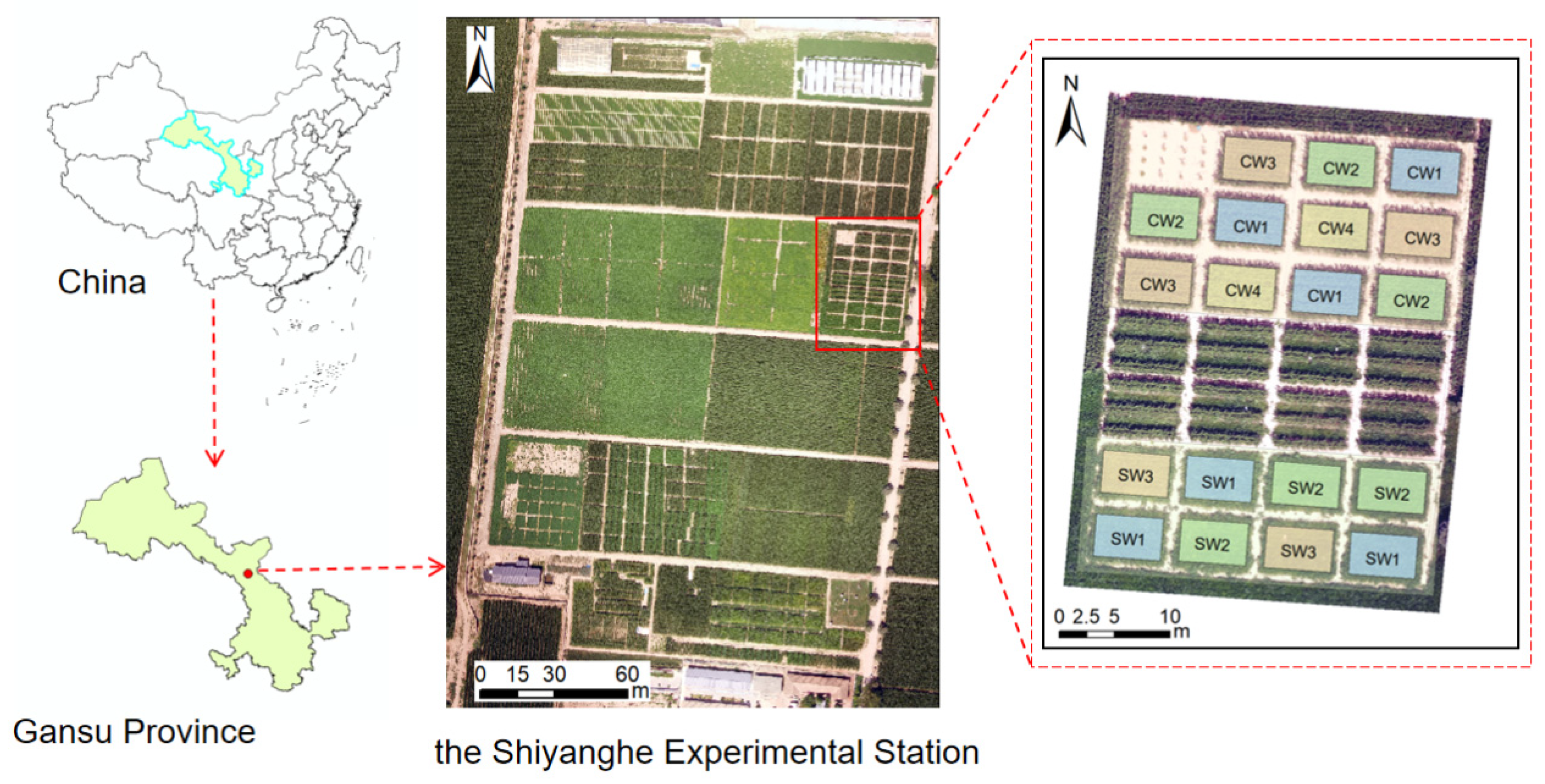

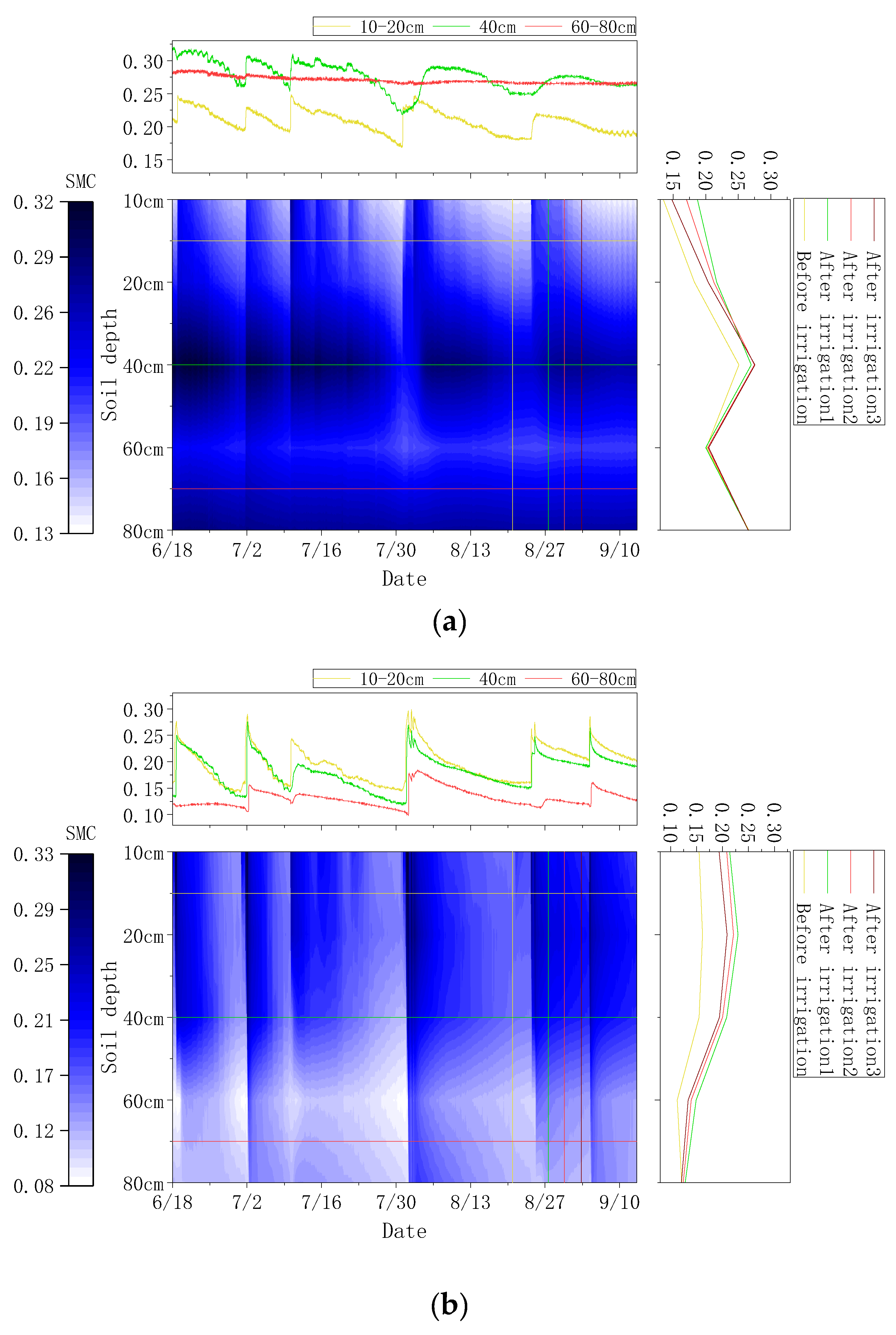
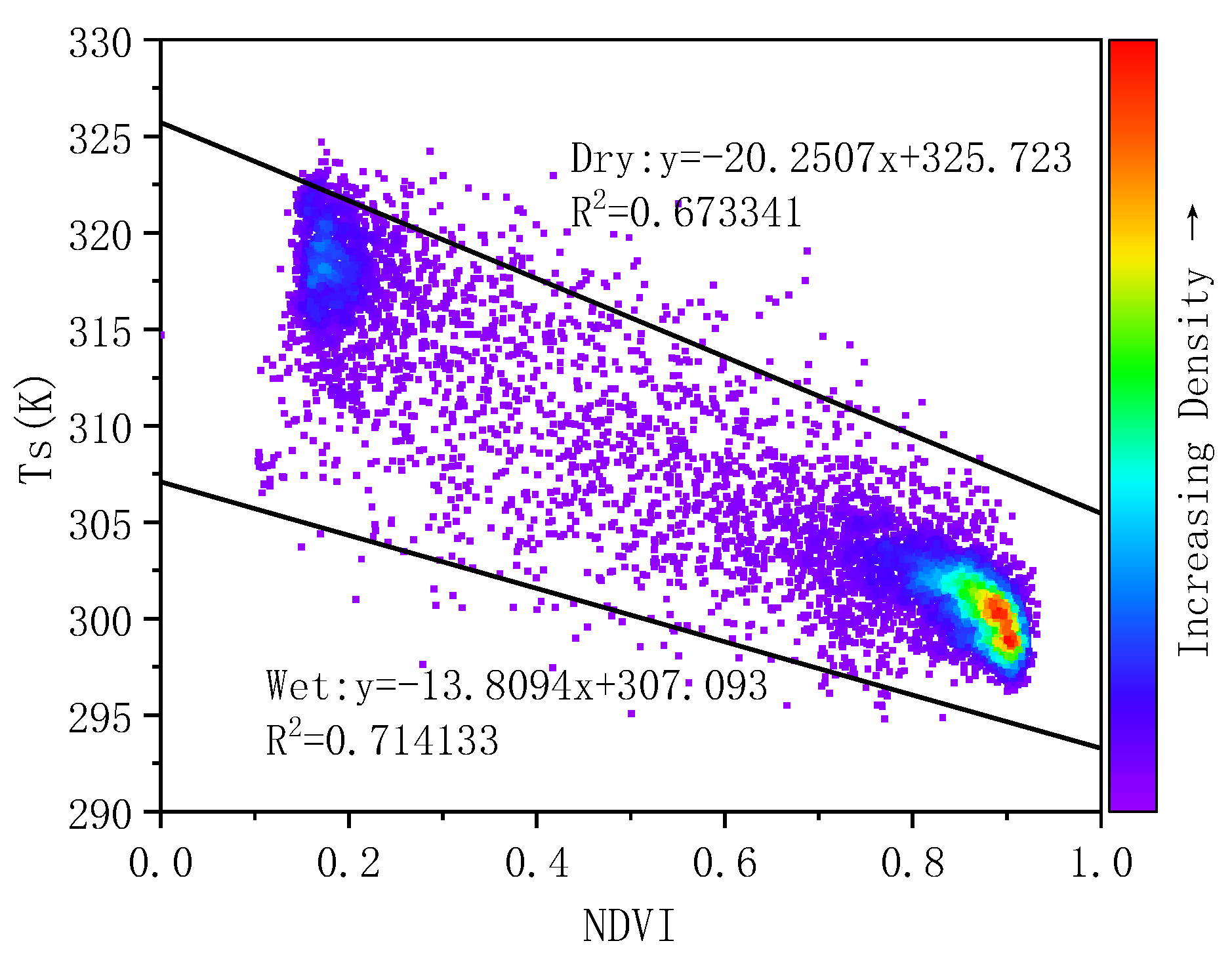
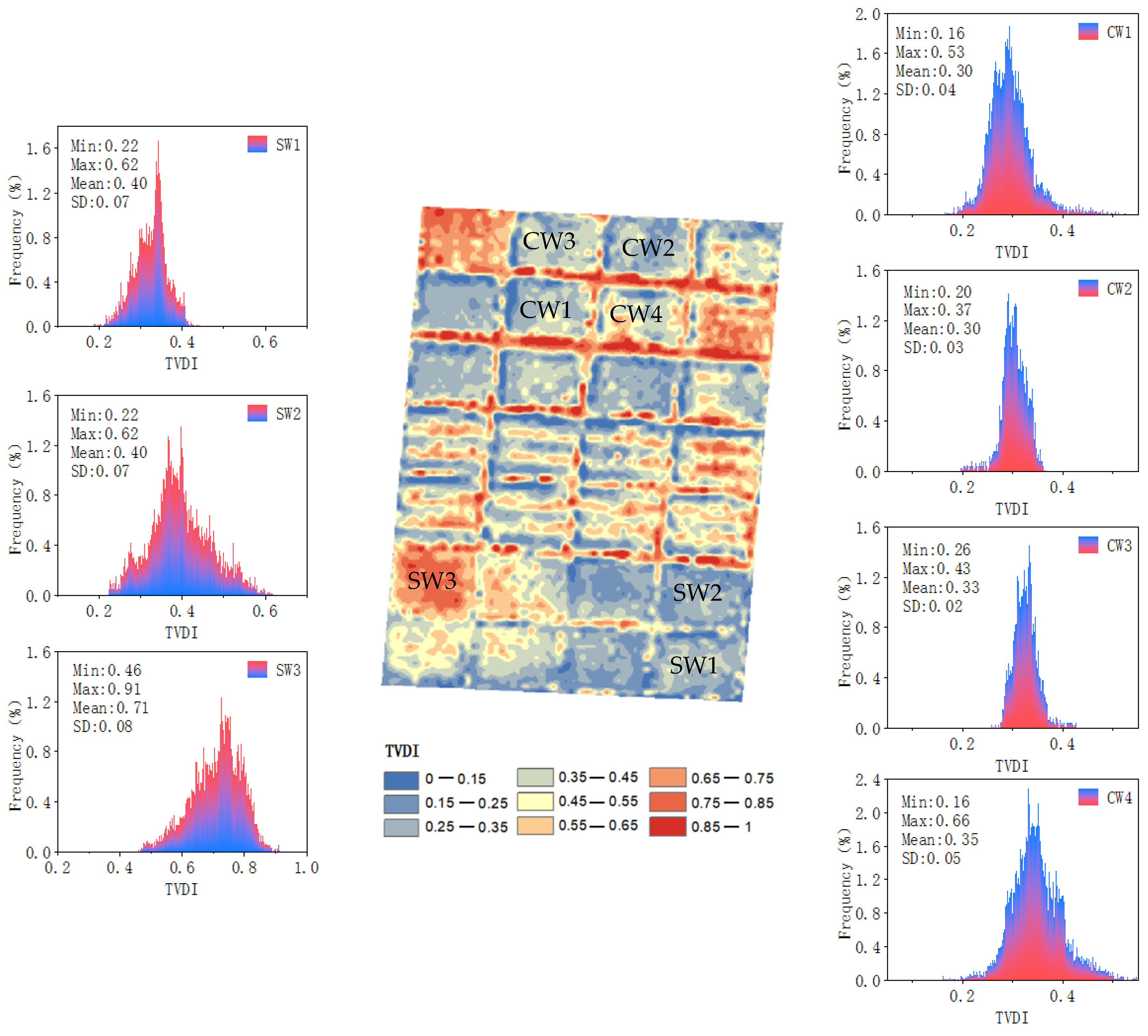






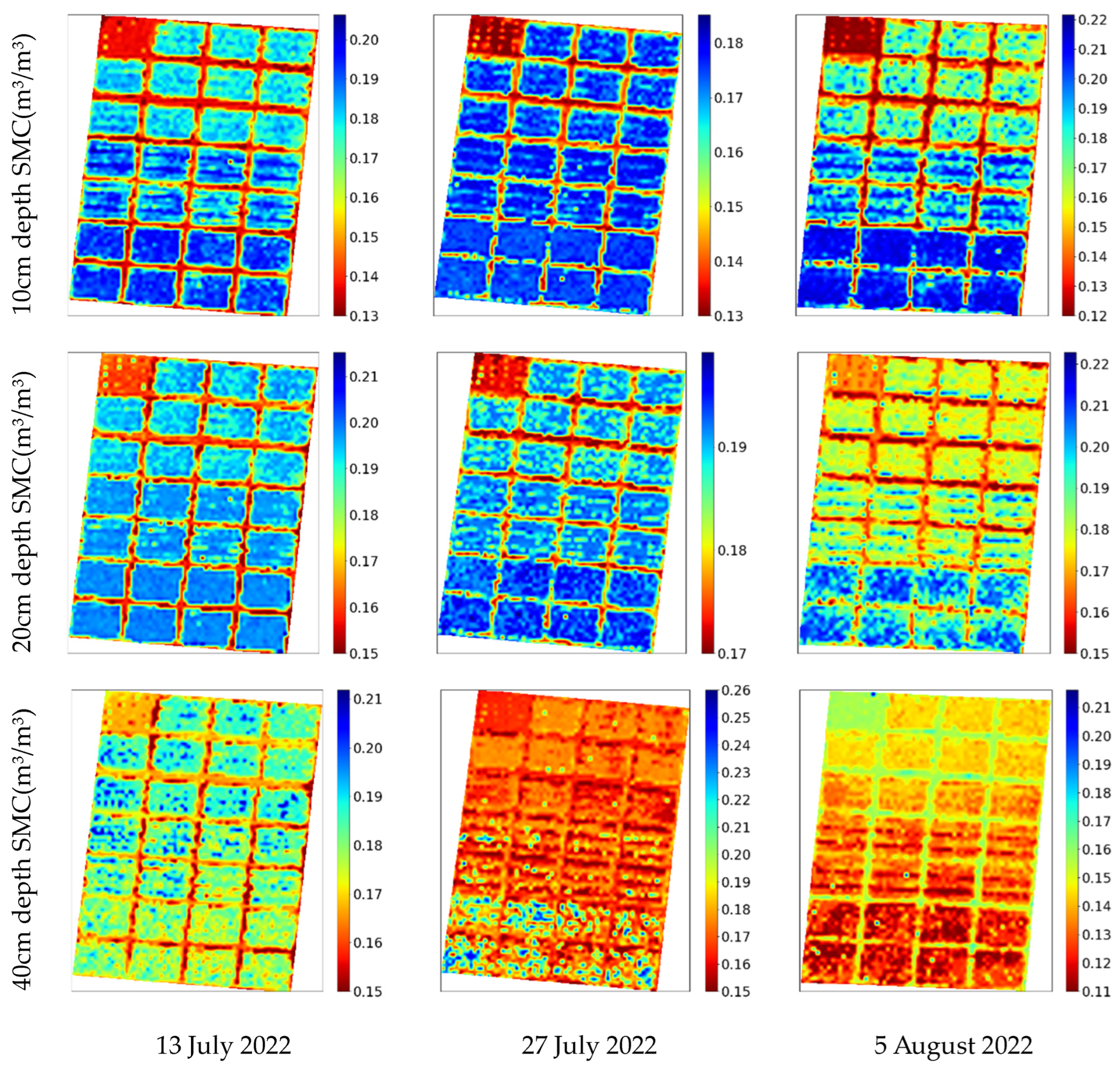
| Sensor Name | Sensor Type | Spectral Region (µm) | Resolution (Pixels) | Field of View (H° × V°) |
|---|---|---|---|---|
| RGB camera | DJI Zenmuse Z3 | N/A | 1240 | 92° (wide-angle)–35° (tele) |
| Multispectral camera | Micasense RedEdge-MX | 0.475, 0.560, 0.668, 0.717, 0.842 | 1280 × 960 | 47.2° × 35.4° |
| Thermal camera | Flir Vue Pro R64 | 7.5–13.5 | 640 × 512 | 32.0° × 26° |
| Sensor | Spectral Index | Formulation | References |
|---|---|---|---|
| MS | Normalized difference vegetation index (NDVI) | NDVI = (NIR − R)/(NIR + R) | [41] |
| Normalized difference vegetation index 2 (NDVIgb) | NDVIgb = (G − B)/(G + B) | [42] | |
| Ratio vegetation index (RVI) | RVI = NIR/R | [43] | |
| Ratio vegetation index 2 (RVI2) | RVI2 = NIR/G | [44] | |
| Triangular vegetation index (TVI) | TVI = 60 (NIR − G) − 100(R − G) | [45] | |
| Enhanced vegetation index (EVI) | EVI = 2.5 (NIR − R)/(NIR + 6 R − 7.5B + 1) | [46] | |
| Green index (GI) | GI = G/R | [47] | |
| Soil-adjusted vegetation index (SAVI) | SAVI = 1.5 (NIR − R) (NIR + R + 0.5) | [48] | |
| Optimized soil-adjusted vegetation index (OSAVI) | OSAVI = 1.16 (NIR − R)/(NIR + R + 0.16) | [49] | |
| Structure insensitive pigment index (SIPI) | SIPI = (NIR − B)/(NIR + B) | [50] | |
| Transformed chlorophyll absorption in reflectance index (TCARI) | TCARI = 3[(RE − R) − 0.2(RE − G)(RE/R)] | [51] | |
| Modified chlorophyll absorption in reflectance index (MCARI) | MCARI = [(RE − R) − 0.2(RE − G)](RE/R) | [51] | |
| Modified simple ratio index (MSR) | MSR = (NIR/R − 1)/(NIR/R + 1)1/2 | [52] | |
| Green normalized difference vegetation index (GNDVI) | GNDVI = (NIR − G)/(NIR + G) | [53] | |
| Simple ratio pigment index (SRPI) | SRPI = B/R | [50] | |
| Normalized pigment chlorophyll index (NPCI) | NPCI = (R − B)/(R + B) | [54] | |
| Plant senescence reflectance index (PSRI) | PSRI = (B − R)/G | [55] | |
| Visible Atmospheric Resistant Index (VARI) | VARI = (G − R)/(G + R − B) | [56] | |
| Color Index of Vegetation Extraction (CIVE) | CIVE = 0.44R − 0.81G + 0.39B + 18.79 | [57] | |
| TIR | Temperature vegetation dryness index (TVDI) | TVDI = (Ts − Tsmin)/(Tsmax − Tsmin) | [58] |
| Crop water stress index (CWSI) | CWSI = (Tc − Tw)/(Td − Tw) | [59] | |
| Canopy temperature depression (CTD) | CTD = Tc − Ta | [60,61] | |
| Vegetation transpiration coefficient (hac) | hac = (Tc − Ta)/(Tcp − Ta) | [62,63] |
| Sensor | Spectral Index | d10 cm | d20 cm | d40 cm | d60 cm | d80 cm |
|---|---|---|---|---|---|---|
| MS | CIVE | −0.245 ** | −0.240 ** | −0.089 ** | −0.155 ** | −0.460 ** |
| EVI | 0.257 ** | 0.225 ** | 0.129 ** | 0.074 * | 0.281 ** | |
| GI | 0.310 ** | 0.136 ** | 0.059 * | 0.154 ** | 0.499 ** | |
| GNDVI | 0.084 ** | −0.091 ** | 0.032 | −0.060 * | −0.014 | |
| MCARI | 0.339 ** | 0.215 ** | 0.067 * | 0.185 ** | 0.642 ** | |
| MSR | 0.253 ** | 0.142 ** | 0.075 ** | 0.043 | 0.225 ** | |
| NDVI | 0.106 ** | −0.047 | 0.037 | 0 | 0.116 ** | |
| NDVIgb | 0.373 ** | 0.199 ** | −0.005 | 0.192 ** | 0.631 ** | |
| NPCI | −0.070 * | 0.024 | −0.081 ** | −0.009 | −0.081 ** | |
| OSAVI | 0.219 ** | 0.154 ** | 0.100 ** | 0.052 | 0.224 ** | |
| PSRI | 0.084 ** | −0.018 | 0.060 * | 0.024 | 0.128 ** | |
| RVI | 0.312 ** | 0.112 ** | 0.078 ** | 0.090 ** | 0.367 ** | |
| RVI2 | 0.137 ** | −0.052 | 0.047 | −0.049 | 0.02 | |
| SAVI | 0.314 ** | 0.297 ** | 0.157 ** | 0.101 ** | 0.396 ** | |
| SIPI | 0.212 ** | −0.016 | 0.019 | 0.023 | 0.248 ** | |
| SRPI | −0.356 ** | −0.238 ** | −0.01 | −0.117 ** | −0.471 ** | |
| TCARI | −0.112 ** | −0.105 ** | −0.01 | 0.053 | 0.01 | |
| TVI | 0.289 ** | 0.266 ** | 0.141 ** | 0.093 ** | 0.352 ** | |
| VARI | 0.242 ** | 0.073 * | 0.052 | 0.104 ** | 0.390 ** | |
| TIR | TVDI | 0.044 | 0.217 ** | 0.106 ** | 0.063 * | −0.01 |
| CTD | −0.211 ** | −0.139 ** | −0.054 | 0.029 | −0.001 | |
| CWSI | −0.170 ** | 0.167 ** | 0.097 ** | −0.053 | −0.454 ** | |
| ha | −0.132 ** | −0.145 ** | 0.016 | −0.05 | −0.301 ** |
| Training Set | Testing Set | |||||||||||
|---|---|---|---|---|---|---|---|---|---|---|---|---|
| 10 cm | 20 cm | 40 cm | 60 cm | 80 cm | 10 cm | 20 cm | 40 cm | 60 cm | 80 cm | |||
| soybean | MS | R2 | 0.82 | 0.88 | 0.47 | 0.36 | 0.42 | 0.74 | 0.78 | 0.38 | 0.28 | 0.34 |
| RMSE (%) | 0.011 | 0.133 | 0.094 | 0.408 | 0.22 | 2.669 | 0.225 | 1.049 | 0.015 | 1.1 | ||
| TIR | R2 | 0.82 | 0.82 | 0.28 | 0.29 | 0.24 | 0.74 | 0.72 | 0.03 | 0.01 | 0.08 | |
| RMSE (%) | 0.017 | 0.021 | 0.332 | 0.068 | 0.024 | 0.248 | 0.309 | 8.13 | 2.026 | 0.672 | ||
| MS + TIR | R2 | 0.82 | 0.89 | 0.53 | 0.36 | 0.42 | 0.78 | 0.85 | 0.46 | 0.26 | 0.32 | |
| RMSE (%) | 1.16 | 0.989 | 0.598 | 1.698 | 0.15 | 0.529 | 0.208 | 0.928 | 1.878 | 1.266 | ||
| corn | MS | R2 | 0.53 | 0.81 | 0.82 | 0.32 | 0.32 | 0.33 | 0.67 | 0.68 | 0.15 | 0.14 |
| RMSE (%) | 0.481 | 0.223 | 0.057 | 0.504 | 0.82 | 2.58 | 2.897 | 1.637 | 1.037 | 3.687 | ||
| TIR | R2 | 0.43 | 0.79 | 0.75 | 0.33 | 0.31 | 0.26 | 0.61 | 0.6 | 0.19 | 0.14 | |
| RMSE (%) | 0.152 | 0.351 | 0.164 | 0.273 | 0.173 | 2.476 | 3.387 | 1.045 | 3.793 | 1.823 | ||
| MS + TIR | R2 | 0.55 | 0.85 | 0.89 | 0.4 | 0.42 | 0.4 | 0.7 | 0.73 | 0.24 | 0.28 | |
| RMSE (%) | 0.433 | 0.032 | 0.009 | 0.738 | 0.821 | 1.287 | 0.571 | 1.317 | 2.377 | 7.589 | ||
| Growth Period | R2 | MAE | |
|---|---|---|---|
| Soybean (10–20 cm) | Flowering stage | 0.92 ± 0.05 a | 0.006 ± 0.002 ab |
| Podding stage | 0.84 ± 0.12 a | 0.005 ± 0.002 b | |
| Filling stage | 0.86 ± 0.04 a | 0.008 ± 0.002 ab | |
| Maturity stage | 0.63 ± 0.11 b | 0.01 ± 0.004 a | |
| Corn (10–40 cm) | Jointing stage | 0.79 ± 0.07 a | 0.011 ± 0.005 c |
| Tasseling stage | 0.56 ± 0.13 b | 0.012 ± 0.003 c | |
| Filling stage | 0.72 ± 0.09 a | 0.014 ± 0.004 ab | |
| Maturity stage | 0.24 ± 0.09 c | 0.022 ± 0.014 a |
Disclaimer/Publisher’s Note: The statements, opinions and data contained in all publications are solely those of the individual author(s) and contributor(s) and not of MDPI and/or the editor(s). MDPI and/or the editor(s) disclaim responsibility for any injury to people or property resulting from any ideas, methods, instructions or products referred to in the content. |
© 2024 by the authors. Licensee MDPI, Basel, Switzerland. This article is an open access article distributed under the terms and conditions of the Creative Commons Attribution (CC BY) license (https://creativecommons.org/licenses/by/4.0/).
Share and Cite
Zhang, Y.; Yang, X.; Tian, F. Study on Soil Moisture Status of Soybean and Corn across the Whole Growth Period Based on UAV Multimodal Remote Sensing. Remote Sens. 2024, 16, 3166. https://doi.org/10.3390/rs16173166
Zhang Y, Yang X, Tian F. Study on Soil Moisture Status of Soybean and Corn across the Whole Growth Period Based on UAV Multimodal Remote Sensing. Remote Sensing. 2024; 16(17):3166. https://doi.org/10.3390/rs16173166
Chicago/Turabian StyleZhang, Yaling, Xueyi Yang, and Fei Tian. 2024. "Study on Soil Moisture Status of Soybean and Corn across the Whole Growth Period Based on UAV Multimodal Remote Sensing" Remote Sensing 16, no. 17: 3166. https://doi.org/10.3390/rs16173166
APA StyleZhang, Y., Yang, X., & Tian, F. (2024). Study on Soil Moisture Status of Soybean and Corn across the Whole Growth Period Based on UAV Multimodal Remote Sensing. Remote Sensing, 16(17), 3166. https://doi.org/10.3390/rs16173166





